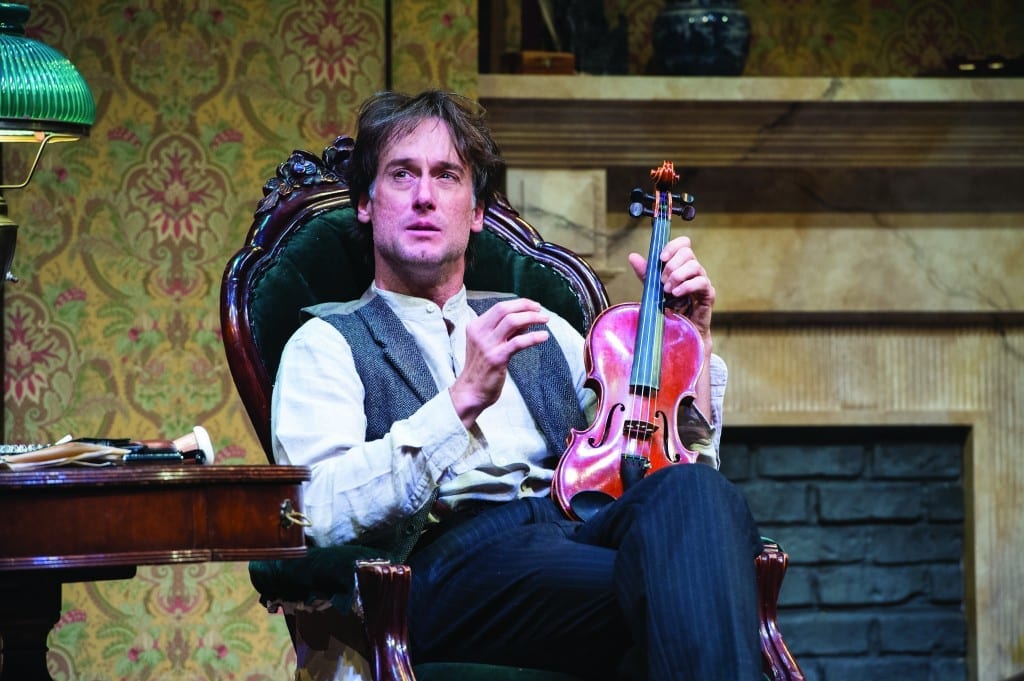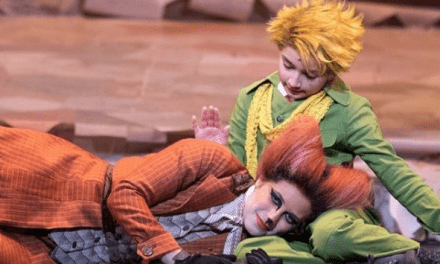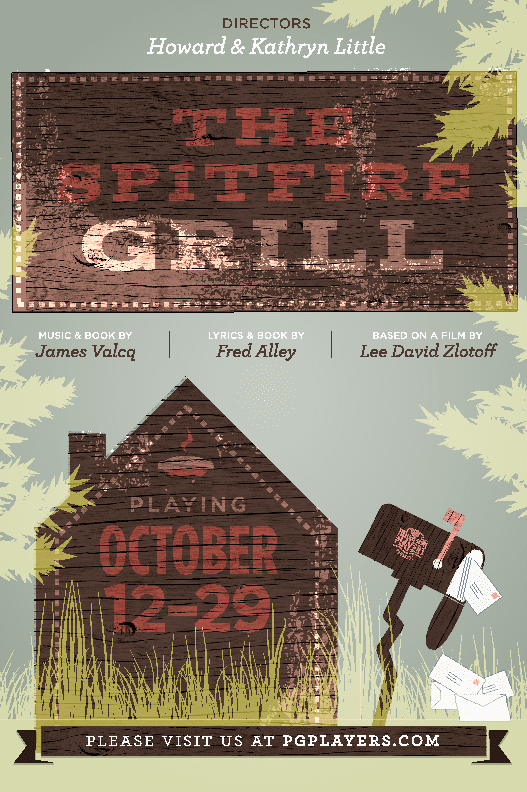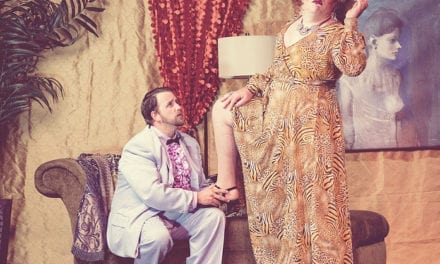CEDAR CITY — In one of the first scenes of Sherlock Holmes: The Final Adventure the title character and his old friend and assistant, Doctor Watson, reunite for the first time in ages. In trademark Holmes style he notices a minute detail—a series of parallel scratches on the side of Watson’s shoe—and makes a stunningly accurate deduction—that Watson had recently taken a long country walk. This story is emblematic of the play as a whole. In reality, Holmes’s logic is faulty. Even if an event (like a country walk) can produce a clue (like a scratched shoe), it does not necessarily mean that the clue must have been produced by that particular event. Watson may have scratched his shoe on an iron fence in the city or on a cobblestone. Like this Holmesian sophistry, much of Sherlock Holmes: The Final Adventure, falls apart upon closer scrutiny.

J. Todd Adams as Sherlock Holmes in the Utah Shakespeare Festival’s 2014 production of Sherlock Holmes: The Final Adventure. (Copyright Utah Shakespeare Festival, 2014. Photo by Karl Hugh.) Show closes October 18, 2014.
The tale of Sherlock Holmes: The Final Adventure is simple. Watson and Holmes reunite for what is to be Holmes’s last case: the King of Bohemia (Aaron Galligan-Stierle) is being blackmailed because of an earlier illicit romance. The King enlists Holmes to find out who is blackmailing him and to retrieve the photographic proof of the relationship. Holmes quickly deduces that his arch-nemesis, the criminal mastermind Professor Moriarty (Roderick Peeples), is part of the blackmail scheme, and Holmes aims to put Moriarty behind bars once and for all.

Roderick Peeples (left) as Professor Moriarty and Melinda Pfundstein as Irene Adler in the Utah Shakespeare Festival’s 2014 production of Sherlock Holmes: The Final Adventure. (Copyright Utah Shakespeare Festival, 2014. Photo by Karl Hugh.)
The biggest problem with this play is its script, and the herculean efforts of its cast cannot overcome the problems of Steven Dietz’s dialogue (which is based on an 1899 play by William Gillette and Sir Arthur Conan Doyle). The play is extremely wordy, and the characters spend far more time talking about their problems than actually dealing with them. Much of the stage time is spent talking interminably about clues or creating elaborate, detailed plans—which are usually executed much more quickly in the following scene. Dietz seemed to want to recreate the feel of the Victorian melodramas that were popular when Sherlock Holmes-mania was at its peak. Unfortunately, this means flat, uninteresting characters, creeky dialogue, and a lack of any real emotion. Dietz’s script, for example, never explains why Moriarty is supposedly responsible for all crime in London or why he would want to do such a thing. It merely says that he is, and the audience is expected to believe the hyperbole.

Brian Vaughn (left) as Doctor Watson and J. Todd Adams as Sherlock Holmes in the Utah Shakespeare Festival’s 2014 production of Sherlock Holmes: The Final Adventure. (Copyright Utah Shakespeare Festival, 2014. Photo by Karl Hugh.)
But the job of a director is to make a script—even a flawed script—work on stage. Regrettably, J. R. Sullivan failed to paper over the script’s flaws. As a result, I never saw evidence of Holmes and Watson’s deep friendship, and character actions rarely made sense. (Often it wasn’t clear why Moriarty’s henchmen weren’t attacking Holmes when he was in the same room as them, meandering around them as he gabbed.) Sullivan instead chose to focus on dialogue and the greater formality of the era, at the expense of emotion and character development. As a result, the audience was expected to believe that there was an irresistible attraction between Sherlock Holmes and Irene Adler (Melinda Pfundstein) when in reality they had only exchanged a few meaningful glances and had a few overly formal conversations.

Drew Shirley (left) as James Larrabee, J. Todd Adams as Sherlock Holmes, David Pichette as Sid Prince, and Bree Murphy as Madge Larrabee in the Utah Shakespeare Festival’s 2014 production of Sherlock Holmes: The Final Adventure. (Copyright Utah Shakespeare Festival, 2014. Photo by Karl Hugh.)
Not that Pfundstein was given much to do. With the exception of the scene in the second act in the gasworks, her character does little more than look doe-eyed at Holmes. Likewise, for most of the play Brian Vaughn is forced, in the role of Doctor Watson, to be the receptacle for Holmes’s inexhaustible verbosity. In the few moments when these actors actually do something, they perform superbly (such as Pfundstein in the gasworks scene or Vaughn in his interactions with Galligan-Stierle). It was a shame that such talent had to be wasted in this production. Indeed, I pitied the entire cast, most of whom I had seen this season in better work that provided them the opportunity to display a broader array of their talents.
As Sherlock Holmes, J. Todd Adams had more stage time than any other actor in the cast. He seemed to enjoy the role, and he handled the part with expertise. Unfortunately, his portrayal of Sherlock Holmes was arrogant and smug. Instead of brilliant and endearing, this Sherlock Holmes is an insufferable know-it-all. This created another barrier to my enjoyment of the show.
On the other hand, I applaud the technical artists for their recreation of turn-of-the-20th century London. Jo Winiarski‘s set is a work of art, and I appreciated the level of detail in creating Holmes’s parlor and the brick walls of the various buildings. The reveal of the gasworks set was particularly rewarding. Rachel Laritz supported the formal nature of the dialogue, and the starched collars and bustles were constant reminders of a bygone era. However, Barry Funderburg‘s music and sound design did more than any other aspect of the production to create tension in the play. The moods he created in the scene changes and incidental music were the most believable part of the production.
Although I didn’t enjoy many aspects of Sherlock Holmes: The Final Adventure, it is not fully without merit. The pleasant technical elements, the flashes of acting brilliance, and the occasionally witty Oscar Wilde-esque jokes can’t be overlooked. Furthermore, fans of the Sherlock Holmes (such as the woman sitting next to me) will likely enjoy a live incarnation of the classic detective. I just recommend that audience members leave the magnifying glass at home and let Sherlock Holmes do all the investigating.





